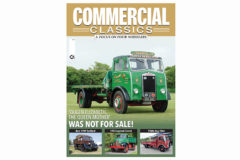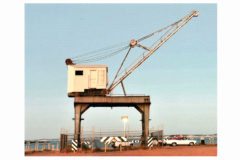The life and times of Jimmy
Posted by Chris Graham on 27th January 2021
Peter Love takes a nostalgic look at the life and times of Jimmy, an Aveling & Porter road locomotive, and the first he ever stood on.

The life and times of Jimmy: This 1900 Aveling & Porter LC6 was the first ever engine that I stood on, way back in 1954.
I’ve always had a soft spot for this 1900 Aveling & Porter LC6 overhead valve compound No. 4561, road locomotive, called Jimmy. It was back in June 1954 that my uncle John placed me on the footplate of this very engine, at Chris Lambert’s annual and pioneering ‘steam-up day’. My late father, WS Love, had steamed the engine earlier that day, and was looking after it.
When I was lifted on, father had the water pump going and, as only Avelings do, it was ‘rocking and rolling’ back and forth as the pump slowly replenished the boiler. I ended up screaming my head off, though, and my mother was called to take me away, in disgrace! But, once back on the ground, I soon recovered and ended up going home on the train, black as the Ace of Spades from all the coal smoke produced by the engines!
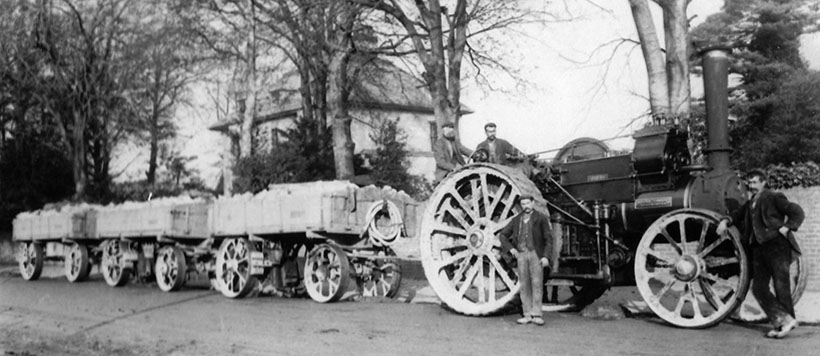
Jimmy seen at Pembury, Kent, in its very early days, with those 7ft rear wheels. (Pic: WS Love Collection)
Chance reunion
I was not reunited with the engine until May 1977, at the NTET Jubilee Rally at Clapham Common, organised by John Crawley. Jimmy was then owned by Derek Trice, of maroon-coloured Tillingbourne Valley Bus Services fame; he ran 13 ex-London County Guy GS buses in his extensive fleet.
However, his steam engines were placed outside the garage, and were spotted while travelling on the cross-country Tonbridge-Redhill-Guildford-Reading railway line. The Trice fleet, at that time, included the Burrell DCC showman’s engine now owned by the Ragsdales, and the Burrell road locomotive now in the Saunders Collection – which was sold to tailor, Billy King at Headcorn, before it travelled to Bedfordshire.

Left-to-right: In the Lambert yard in 1951, with AP No.4561 Jimmy, No.9149 and JF B4 No.11637 (now Winifred) with its sister behind No.11636, which was later scrapped by Hardwicks (Pic: Bob Pratt)
At that NTET event Derek Trice – who was known for being rather grumpy – was taken aback when father asked him what he thought about the unique Lambert patent spring gear. He struck up a conversation with father that went on a while, and invited him to have a steer of the engine later on. He complained about the whirring ‘wind-up’ noise from the gears, and one got the feeling that he wasn’t a fan of this two-speed engine.
Popular Avelings
Remember that, at the turn of the 20th century, there were more Aveling road locomotives about than Burrell and Fowler products. Cornishman and ex-Devon County Council Marshall No. 62121 The Whale traction engine owner, Jack Trounson, once told me that Hosken, Trevithick & Polkinghorne bought a new Fowler RL, which Fowlers sent a man to bed-in. The new owners also used an Aveling road locomotive, which I presume was an 8hp OHC RLC8.
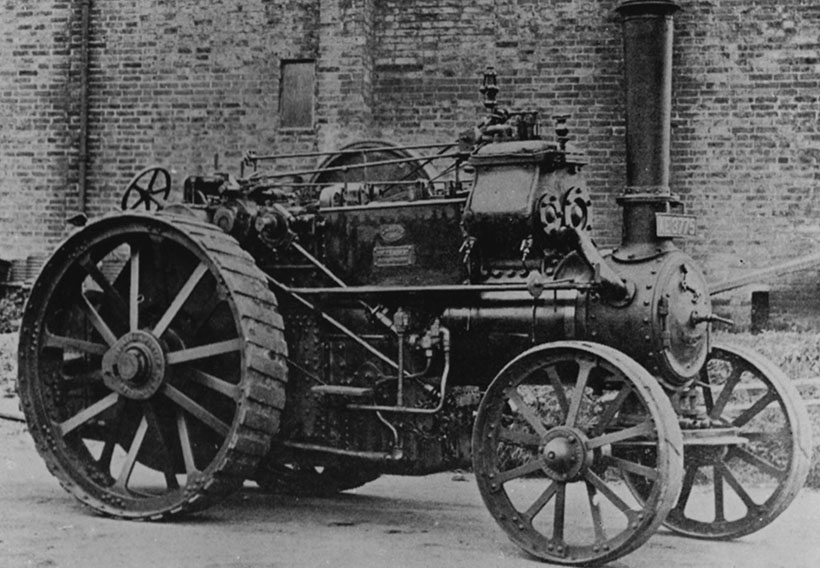
Jimmy in 1938, in Lambert’s entrance, by the last houses. (Pic: WS Love Collection)
The driver of this engine challenged the Fowler man and, with three wagons apiece, they took off together. Jack said that the Aveling two-speeder was a better puller up the Cornish hills to Hayle, and it was all parked-up before the Fowler had even arrived! But, it’s also said that Fowler RLs were better pullers up the Cornish hills compared to Robey compounds, so make of that what you will! But what is certain is that Aveling road locomotives were powerful engines when in good order.
The first Aveling & Porter Fowler-style overhead inside slide-valve compound road locomotives arrived in 1892. This type of cylinder block was used until 1901-’02, as Aveling’s own style, outside slide-valve compound block became standard fitment until the ‘dreaded’ piston-valve came in, but that’s another story. It’s said that the company made 113 8hp compound RLs, mostly three-speed engines, between 1892 and 1920, and some 62 6hp compound RLs (including three, 6hp crane engines) between 1894 and 1922, using both types of cylinder blocks.
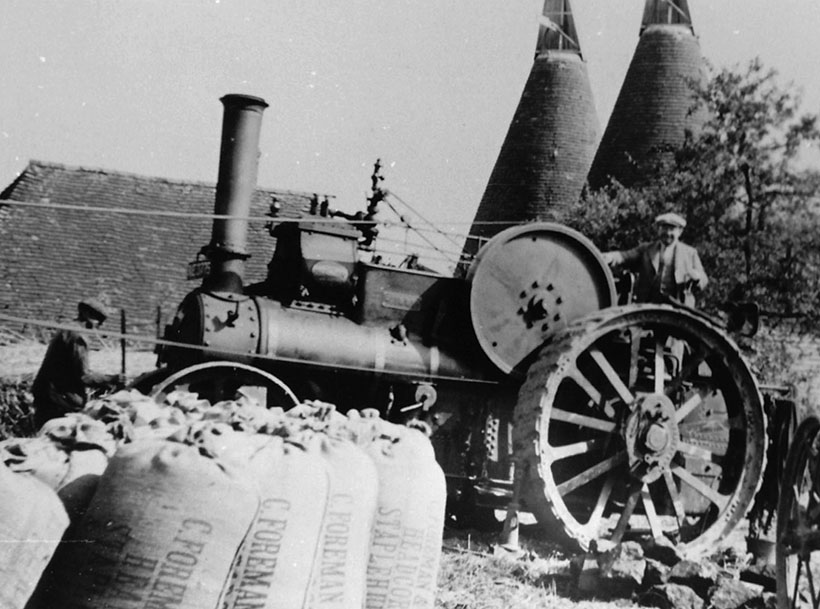
Seen in June 1937 with the famous postman, Jack Pierson on board, who ended up with Marshalls of all kinds across the Pennines in preservation times. This scene is near Headcorn, in Kent. (Pic: John Russell/Peter Love Collection)
This 1900 engine No. 4561 was new to engineers and contractors Clark Maylam & Sons of Lenham, Kent. The company ran road locomotives, traction engines, ploughing engines and road rollers – mostly Aveling products, but not exclusively. It was in 1903 that Lamberts at Horsmonden, Kent, purchased the engine to use in its haulage fleet. The company was started by William Lambert’s father in 1847, and had operated steam engines from 1875.
Struggling-on
William Lambert died in 1915 and, although he was a good engineer, he ran the business badly. When his son, Christopher W Lambert (1881-1955) took over, he struggled through, but was a much better businessman than his father. He kept the business afloat and became a progressive operator/dealer who, by the end, saw nearly 200 engines go through his hands – yes, that many!
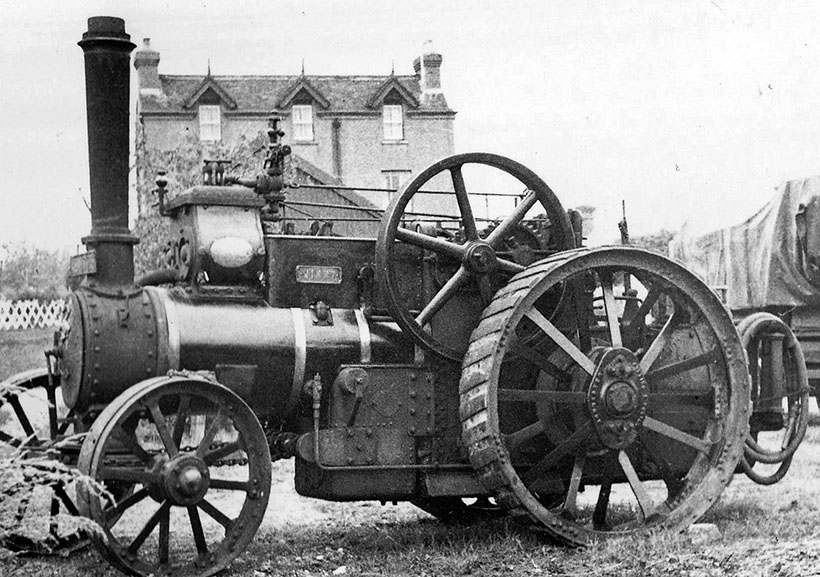
This photograph was taken on June 24th, 1951, and shows the threshing fitment very clearly. (Pic: WS Love)
He used many of his purchases in the business, for road haulage, threshing, sawing, ploughing and road rolling. But he sold a lot on, too, and even bought some of them back, while some were scrapped when they were just too worn out. He also had stone quarries on the south coast, at Pevensey. Chris was ‘the’ pioneer steam preservationist in the south east of England, and did more than most to save engines; Allchin Royal Chester being a prime example, thanks to a phone call from Bill Hughes.
He tried to find the oldest and the newest. He very much encouraged people to become owners in the 1940s and 1950s, and let people keep their engines in his yard for no rent. It was his influence that possibly got my father the job of secretary of the Road Locomotive Society in those ‘heady’ days of the early 1950s.
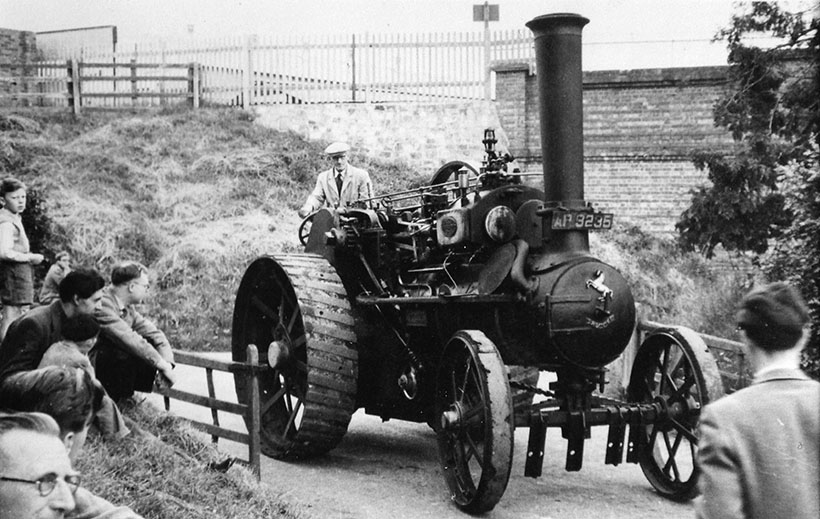
The other ‘Jimmy’! This 1919 No.9010 6hp sprung traction engine is seen here during the 1954 Horsmonden steam parade. (Pic: WS Love)
Lamberts used No. 4561 out of High Brooms and Pembury brickyards, based near Tunbridge Wells, in Kent. In fact, the High Brooms pit is an industrial estate today, some 10 miles from Horsmonden and Lambert’s yard, which was opposite the Horsmonden railway station. This was part of the 1892, 11-mile Hawkhurst branch, with the junction at Paddock Wood. Interestingly, the engineer of this line was none other than the versatile Colonel Holman Fred Stephens, of light railway fame.
Jimmy was rebuilt early on, with Lambert patent spring axle boxes, and is the only engine known to exist that’s fitted with these today. I believe the patent was granted in 1909, although I stand to be corrected on that.
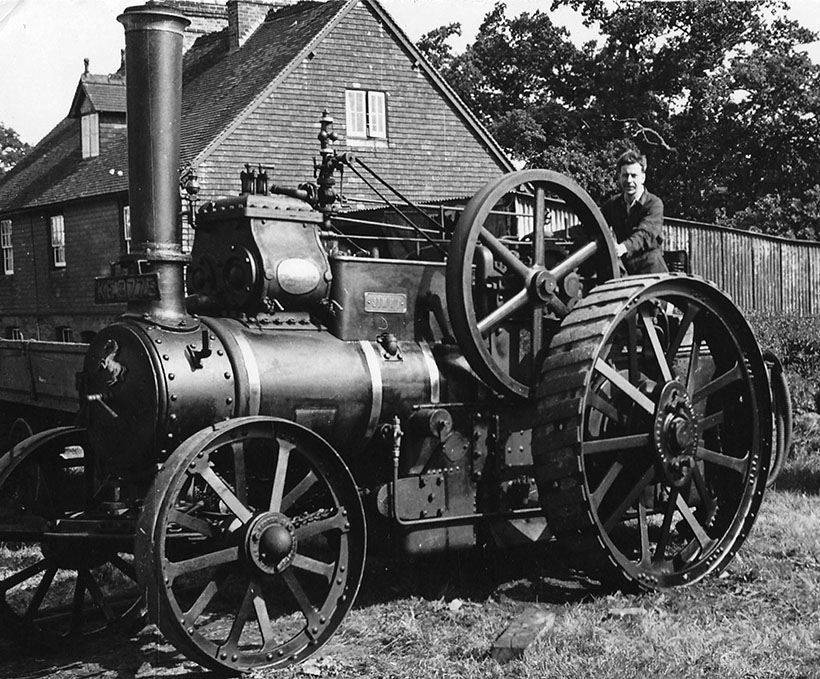
June 20th, 1953, and Jimmy is in steam with WS Love at the helm. (Pic: JJ Love)
So, what was the object of the sprung axle boxes? Well, it was to offer block engines the chance to have a sprung arrangement to take the shocks out of the engine on the road, particularly saving on axle breakage and bearing wear. The jury’s out about whether it worked well, as Jimmy is rather a ‘bouncy’ engine, and perhaps needs setting-up in that area, according to the current owners.
Threshing conversion
Jimmy’s days as a road locomotive pulling wagons were over by the 1920s, and Lambert converted it to a threshing engine. During its working life, it’s said that the cylinder block was replaced, owing to water lying in it. The road locomotive’s 7ft rear wheels, and the larger front wheels, were replaced in 1922, with a smaller set, possibly from AP No. 5498, with the objective of creating an economical threshing engine – the belt would have fouled the original, large front wheels.
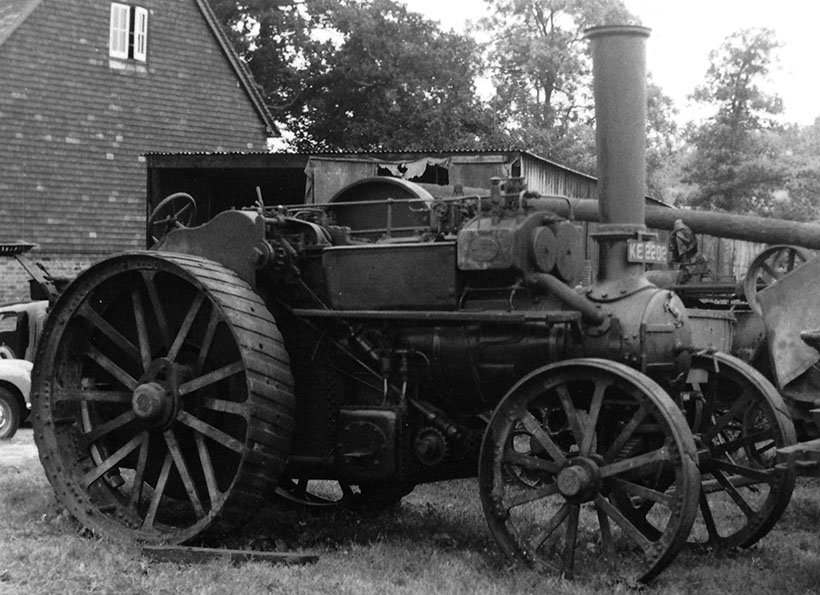
Seen on June 21st, 1952, by John Meredith, the other proper 1920 Aveling & Porter YLD 6hp No.9149 road locomotive that Lambert would sell to John Sparkes before the 1955 auction. It’s now in the Cushing Collection. (Pic: Peter Love Collection)
The famous belt guide pulley was also fitted, as well as a set of governors. The original, solid flywheel was gone by the 1930s, replaced with a spoke-and-disc example was. This was replaced again with another spoked flywheel sometime between 1939 and ‘45, after which the engine entered preservation, although I stand to be corrected on that.
This is how Bert Cheeseman drove Jimmy for many years, and he made a good threshing team foreman. He started out as a driver for Lamberts, as a 17-year-old, and worked for them and Don Eastwood (Roe Roads), who took the yard over for some 68 years.
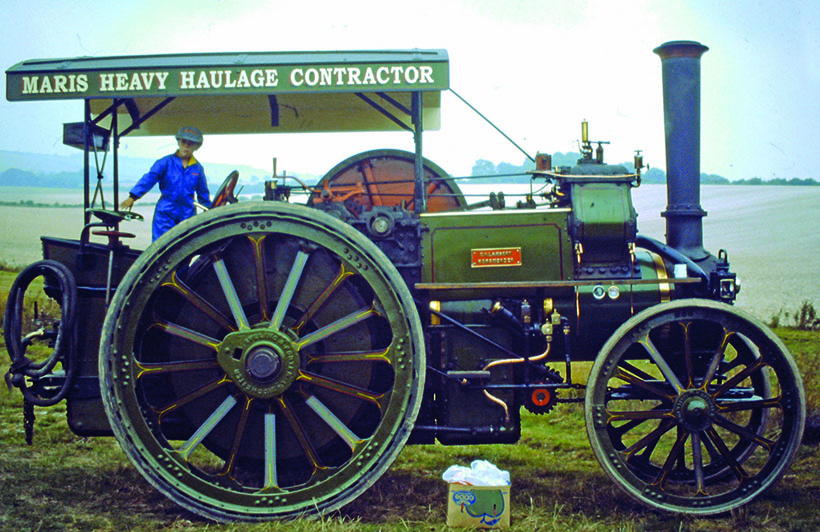
Seen at the Great Dorset Steam Fair in 2000, here’s Jimmy in Dave Maris’ ownership. (Pic: Bob Moorman)
Jimmy in preservation
In preservation times, Jimmy was part of all the 1949 and, officially, 1950-54 Lambert steam parties and Horsmonden parade, held on the last Saturday in June, and was a very popular engine. However, in the yard and also steamed, were other Aveling & Porter compounds, including 1919 KLD No. 9010 6hp, a sprung traction engine known as the Collins Engine.
It was named as such because of the deal that Chris had put together with owner H Collins of Bodiam, East Sussex, who apparently lived in his van in Lambert’s yard for a while. The engine was to end up in the George Cushing collection, looking very original, on show as it is today and, very irritatingly, called Jimmy. This came about, I believe, after George obtained a spare ‘Jimmy’ nameplate from Sparkes of Outwood, Surrey, where he purchased No. 9010 in 1958, and not at the Lambert sale, as people think. Now you know why I feel the engine should be called ‘Collins Engine’, but there we are!
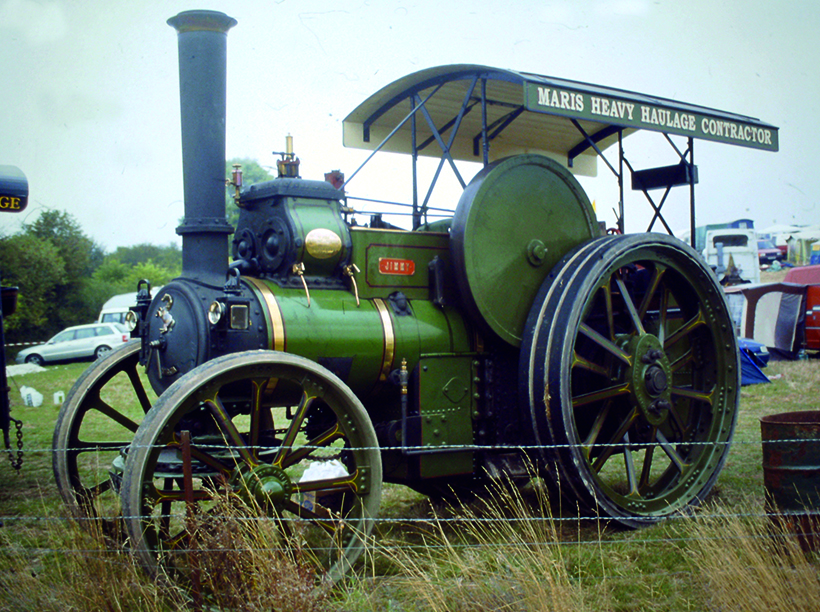
Looking prim and proper in the ownership of Dave Maris, while parked at the Great Dorset Steam Fair in 2000. (Pic: Bob Moorman)
However, Chris did have another genuine Aveling & Porter, three-speed road locomotive still in his yard during the early 1950s – 1920 6hp YLD No. 9149. He’d bought it from William St J Brice in 1938, and sold it not long before his death, to John Sparkes, Outwood, Surrey; coincidently, this engine is also part of the Cushing Collection.
After Lambert’s death, a two-day sale was arranged in June 1955, by Lambert & Symes (later Lambert & Foster), based at Commercial Road, Paddock Wood. The engines were sold, starting with catalogue number 411: 1928 Burrell No. 4081 Fearless, the last Burrell completed at Thetford. It went on to sell for £300 – an amazing amount for the time.
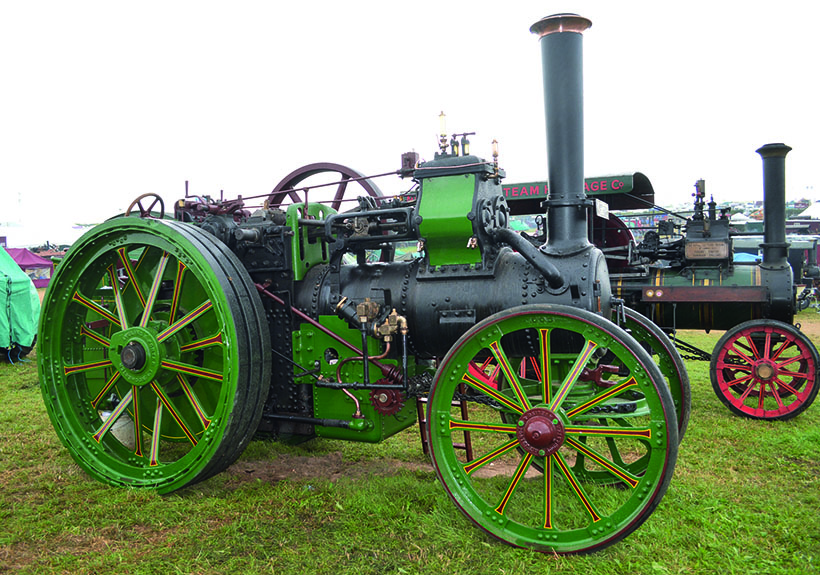
Here’s No.4561 getting ready for the day ahead near the Road Roller Association’s tent, with the pump rod and eccentric missing. (Pic: Bob Moorman)
It set the tone for the sale, and engines sold for more than many people thought possible. When lot number 430 came up, Aveling & Porter No. 4561 road locomotive mounted on steel wheels, with Lambert patent axle boxes, boiler feed pump, injector and set of governors, it changed hands for a more realistic £85. Its new owner was Chris Lambert’s step-daughter, Helen Wilson, of Mill Fields, Cranbrook. Helen also bought lot 418; 1919 Aveling & Porter KLD No. 9010 6hp GP, sprung rear and front compound traction engine for £90. One has to remember that traction engines that were scrapped just post-war, between 1945 and 1950, were sold for £50-60 typically so, by 1955, £85 was still esentially scrap value.
Various owners
The engines basically didn’t do anything; they just sat there with the new owner, and were never rallied. Bob Whitehead tried to encourage them to be steamed and attend the Weald of Kent Traction Engine Society’s rallies at Paddock Wood, but his encouragement fell on deaf ears. It was in 1958/59 that John Sparkes of Outward, Surrey, extracted No. 4561 Jimmy from the Wilsons, as George Cushing had, in 1958, when he bought No. 9010. Today, the latter is basically in the same condition – apart from a set of tubes – as it was then, and has been steamed on occasions at Cushing’s.

Here in the dust are a couple of Aveling old-timers; No.8401 and No.4561, Jimmy. (Pic: Peter Love)
It can’t be said that Sparkes did much with Jimmy, apart from a few jobs with it on his rack saw bench. It then moved on to Derek Trice, who restored the engine to full working order; the firebox was built up by Michael Lugg of Billingshurst, and retubed, making the boiler good again. The engine was tided-up, cleaned and repainted. On that day, back in May 1977, Jimmy looked a treat as it ‘hummed’ along, parading in its green and black livery, with its flywheel now plated again.
In 1985, Trice put Jimmy up for sale, and wanted £21,000 for it. I was put off by Will Day telling me the throat plate was cracked. I went to see it in 1986 and, with the belly tank on, and placed right in front of the throat plate, I couldn’t tell if it was cracked or not. That year was possibly the worst of my life, so I didn’t act on it, although I could have possibly pulled the cash together to do it, but was rather nervous to do so owing to my circumstances.

Here Jimmy looks very dry indeed after so much boiler work, coming down the hill carefully at the 50th Great Dorset Steam Fair. (Pic: Peter Love)
In 1990, Jimmy was advertised for sale in World’s Fair for £25,000, and Aveling man through-and-through Robert Bate, from near Wolverhampton, went along with boiler inspector John Glaze to look over the engine. Remarkably he gave it a clean bill of health and a deal was done at £23,000, after which it was on its way via Len Crane.
There the lagging was stripped, the belly tank removed and a 10-year hydraulic test was carried out. The engine was given a clean bill of health and away went Robert with the engine. He describes Jimmy as very powerful, but rather ‘up and down’ on the springs. He put the seat and belt pulley back on and, although he had the governors for it, he didn’t get around to putting them on.
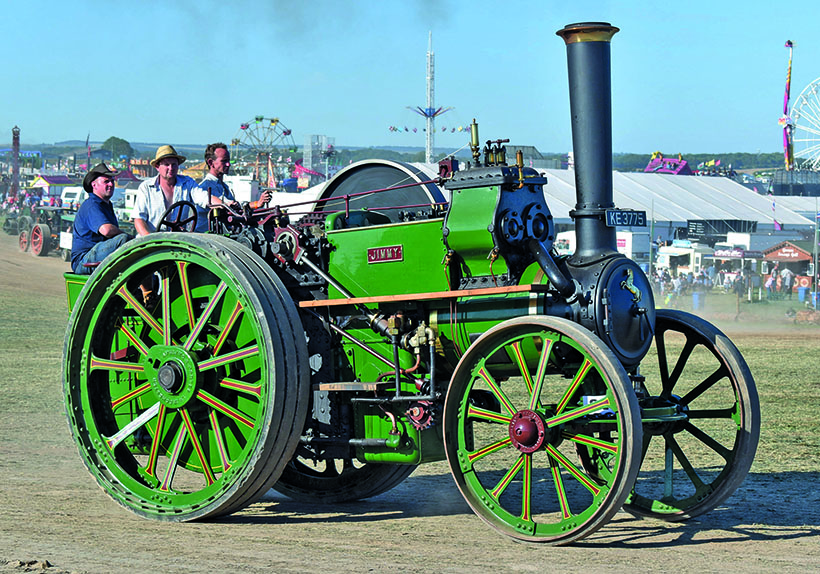
Jimmy takes to the Steamer Hill at the 2019 Great Dorset Steam Fair, looking such a lovely engine with Andrew at the controls, and David Goakes in the tender. (Pic: Bob Moorman)
For various reasons, Robert decided to sell his powerful road locomotive in 1997, and it was purchased by Dave Maris. Dave changed the front wheels for a pair from a portable, making it similar to its 1900 road locomotive days, but didn’t touch the rear. He replaced the gears and extended the bunker and added a roof to the engine, something it never carried in its life before, and somehow, this just didn’t suit it at all.
Dave wanted a change in 2002, and placed a ‘For sale’ board on the engine at the GDSF, as it steamed around the playpen. It attracted much attention, particularly from the Goakes family from March, Cambridgeshire – they’re all very keen Aveling fans. The deal was done in October 2002, Andrew Goakes scraped the money together one way or another, and Jimmy was his!

This isn’t a copy, it’s the 120-year-old Royal Letters Patent plate. (Pic: Peter Love)
He rallied it for a number of years, but time was running out and the engine was on reduced pressure (100lb) – no good for a compound road locomotive like this.
A complete overhaul
Jimmy was taken off the road in 2012 and stripped down by the team; out came the firebox and the backhead was cut out. It was transferred to Mick Maskell’s premises and, in the evenings and at weekends, the team worked on the boiler unit. The objective was to have the engine ready for the GDSF 50th event. A new tombstone went in the backhead, welded in by the late Peter Green; a two-piece boiler barrel was fitted and riveted up, along with a flanged and riveted firebox, tubeplate and smokebox.

The belly tank is very close to the front of the throatplate. (Pic: Peter Love)
The tender was fabricated and new belly tanks were made – the engine certainly got the works! It was only just completed the Monday before the 2018 50th GDSF, but it was loaded to Dorset on the Tuesday. The boiler was very dry, as were the belly tanks, but the clack valve was giving problems. Everyone was pleased just to be there and to rest and enjoy the engine – or so they thought.
On the Wednesday, before the show started, the engine was being steamed around the ‘play pen.’ Around lunchtime, the new pump eccentric got hot and seized, breaking the pump rod and sending it high into the air, over the top of the tender and footplate crew, before landing heavily in the ground pointing down like an arrow flung from its bow.

The fitting that caused all the problems at the Great Dorset Steam Fair in 2018. (Pic: Peter Love)
What a great start! But the team just about coped and the engine was very popular on the Friday and Saturday at the show. Once back at home, various jobs were sorted out on the engine, such as another pump rod and eccentric, and the clack valve height was adjusted, then all was well again. Gone was the incorrect smokebox ring that the previous owner had placed on the engine, and the correct rampant horse was back on for all to see.
A new solid flywheel was cast and machined for the engine by Mark Sheldon of full-size, new-build Foster tractor fame; it fitted like a glove, making the engine look more 1900 than 1922. New lagging was made, and the engine was repainted and ready for the ‘hot’ 2019 GDSF when Jimmy performed well each day and looked superb.
With all that’s been going on in the world recently, Jimmy has only been steamed few times over the past 12 months, notably for Andrew’s father, Michael Goakes’ family and friend’s party recently. Michael really appreciates Jimmy, and is a keen Aveling man; the engine is certainly the star in the family collection today.

That crankshaft eccentric strap and pump rod caused mayhem in 2018 – luckily, nobody was hurt.
So, what’s the future for Jimmy? Well, it’s possible that the crank will be balanced by David Goakes, he says that’s the next step and will certainly help it along its way, as Jeff Burgess found when he balanced the crankshaft on 1905 Aveling 6hp compound No. 5862 Emma – it made the world of difference to his traction engine. Maybe, in time, the Goakes will make those 7ft rear wheels for her? But that’s all for the future.
No matter what, 1900 No. 4561 Jimmy has always been highly respected by all its owners over the years. It’s in a very happy place now, and is certainly a unique engine in the UK today, and a star wherever it goes.
For a money-saving subscription to Old Glory magazine, simply click here



